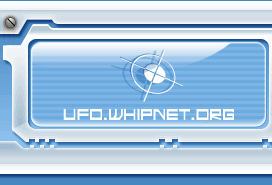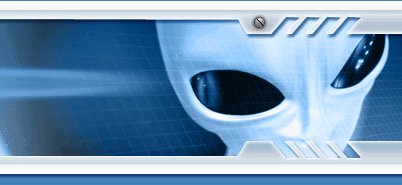The Day After Roswell
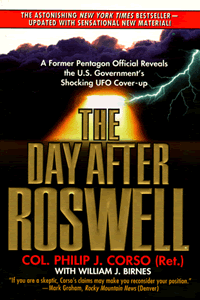 Colonel Philip J. Corso Colonel Philip J. Corso
The Day After Roswell
By Sean Casteel
Retired Army Colonel Philip J. Corso brings a very unique perspective to the many versions of what really happened at Roswell, New Mexico, in 1947. Unlike most people who describe their own experiences with the crashed UFO and the aliens who supposedly died there, Corso comes to the story several years after the fact and tells us what happened in the aftermath of that hugely mysterious incident in the New Mexico desert.
Corso has provided his testimony about how the U.S. government, and especially the military, responded to what they presumed to be the sudden appearance of a hostile alien race in a recently released book called The Day After Roswell (Pocket Books, 1997). From the first hours of initial shock at the crash site to the implementation of the Strategic Defense Initiative (also called "Star Wars") nearly 40 years later, Corso leads us through the twisted trail of secrecy and reveals the desperate need felt by the Defense Department to achieve a military defense capability that would allow the U.S. to respond to an attack from the extra-terrestrials.
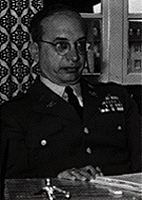 After telling what he acknowledges is simply one of numerous accounts of the actual crash of the UFO and the hurried retrieval of it by soldiers from the nearby 509th Army Air Force Base, which was then followed by an organized intimidation of the locals to force their silence, Corso moves on to tell how he encountered, seemingly by accident, the physical remains of a dead alien that was being shipped to Wright Air Field in Ohio. After telling what he acknowledges is simply one of numerous accounts of the actual crash of the UFO and the hurried retrieval of it by soldiers from the nearby 509th Army Air Force Base, which was then followed by an organized intimidation of the locals to force their silence, Corso moves on to tell how he encountered, seemingly by accident, the physical remains of a dead alien that was being shipped to Wright Air Field in Ohio.
Corso was on night watch at the time at an army base called Fort Riley in Kansas. An enlisted man with whom he had a friendship through a local bowling league was posted as a sentry that night in July 1947, and when Corso approached the enlisted man's post, he was asked in a whisper, "You know what's in here?"
Having had his curiosity aroused, Corso walked into what had formerly been a veterinary hospital for horses during the days of the cavalry. He saw about thirty or so wooden crates stacked together against the far wall of the building. He crossed the room to one of the crates that was already partially open, loosened the nails and looked inside.
"My stomach rolled right up into my throat," he said, "and I was almost sick right then and there."
Corso talked about what he saw.
"The contents," he said, "enclosed in a thick glass container, were submerged in a thick light blue liquid, almost as heavy as a gelling solution of diesel fuel. At first I thought it was a dead child they were shipping somewhere. It was a four-foot human-shaped figure with arms, bizarre-looking four-fingered hands-I didn't see a thumb-thin legs and feet, and an oversized incandescent lightbulb-shaped head that looked like it was floating over a balloon gondola for a chin. I know I must have cringed at first, but then I had the urge to pull off the top of the liquid container and touch the pale gray skin. But I couldn't tell whether it was skin because it also looked like a very thin one-piece head-to-toe fabric covering the creature's flesh."
Corso went on describing the alien body he saw that night.
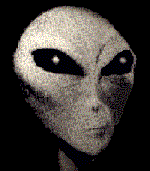 "Its eyeballs must have been rolled way back in its head because I couldn't see any pupils or iris or anything that resembled a human eye," he said. "But the eye sockets themselves were oversized and almond shaped and pointed down to its tiny nose, which didn't really protrude from the skull. It was more like the tiny nose of a baby that never grew as the child grew, and it was mostly nostril. The creature had only a tiny slit for a mouth and it was completely closed, resembling more of a crease or indentation between the nose and the bottom of the chinless skull than a fully functioning orifice." "Its eyeballs must have been rolled way back in its head because I couldn't see any pupils or iris or anything that resembled a human eye," he said. "But the eye sockets themselves were oversized and almond shaped and pointed down to its tiny nose, which didn't really protrude from the skull. It was more like the tiny nose of a baby that never grew as the child grew, and it was mostly nostril. The creature had only a tiny slit for a mouth and it was completely closed, resembling more of a crease or indentation between the nose and the bottom of the chinless skull than a fully functioning orifice."
Corso said he could see no immediate cause of death for the alien.
"I could see no damage to the creature's body," he said, "and no indication that it had been involved in any accident. There was no blood, its limbs seemed intact, and I could find no lacerations on the skin or through the gray fabric."
Corso checked to see if there were any paperwork or shipping invoice in the crate.
"What I found was an intriguing Army Intelligence document," he said, "describing the creature as an inhabitant of a craft that had crash landed in Roswell, New Mexico, earlier that week and a routing manifest for this creature to the log-in officer at the Air Materiel Command at Wright Field and from him to the Walter Reed Army Hospital morgue's pathology section where, I supposed, the creature would be autopsied and stored. It was not a document I was meant to see, for sure, so I tucked it back in the envelope against the inside wall of the crate."
Corso said he missed some of his appointed rounds that night because of the time he spent looking at the creature, but that what he had seen would be worth any trouble he found himself in.
"This thing was truly fascinating," he said, "and at the same time utterly horrible. It challenged every conception I had, and I hoped against hope that I was looking at some form of atomic human mutation. I knew I couldn't ask anybody about it, and because I hoped I would never see it's like again, I came up with explanation after explanation for its existence, despite what I'd read on the enclosed document. It was shipped here from Hiroshima, it was the result of a Nazi genetic experiment, it was a dead circus freak, it was anything but what I knew it said it was-what it had to be: an extra-terrestrial. By the time I slid back behind my desk, it was all a dream. No, not a dream, a nightmare-but it was over and, I hoped, it would never come back."
But whatever destiny decides such things was not willing to let Corso off that easy. When he was assigned in fourteen years later to a post at the Pentagon Research and Development Division, he was presented with a mysterious file cabinet and told it contained extremely sensitive material that would be part of his job duties there at his new assignment.
"I opened the cabinet," he said, "and almost immediately my heart sank. I knew from looking at the shoebox of tangled wires and the strange cloth, from the visorlike head piece and the little wafers that looked like Ritz crackers only with broken edges and colored a dark gray, and from an assortment of other items that I couldn't even relate to the shapes and sizes of things I was familiar with, that my life was headed for a big change. So here it was, some of the material they'd recovered from Roswell. And now, just like a bad penny, it had turned up again."
Corso emphasized that these events were taking place during the time when the Cold War was a constant factor in most political and military situations. Not only was there the uneasy truce between the two super powers, there was also the constant fear that the KGB had infiltrated much of the intelligence network that the U.S. depended on for its defense. Even the CIA was believed to be feeding reports to the White House that were designed by the Russians to make the U.S. more susceptible to the Soviet goal of world domination. Very few people could be trusted and the need to maintain secrecy was considered absolutely vital.
But according to Corso, there was now a second Cold War that was even more fraught with danger. The UFO that crashed at Roswell was presumed to be the downed aircraft of a hostile alien species against whom we had very little in the way of defense. Not only did we seem helpless to fend off any planned invasion that might be the aliens' real purpose here, there was also the constant worry that the Russians themselves might be in league with the aliens as a proxy force to be used in conquering the Free World.
Corso said that it was determined the aliens were hostile soon after the crash at Roswell. That line of reasoning began with a memo from General Nathan Twining, the officer in charge of the Air Materiel Command at Wright Field, who was given the responsibility of dealing with the crash shortly after it occurred.
Twining's 1947 memo acknowledged that the sightings of strange objects in the sky are "something real and not visionary or fictitious." He also marveled at the aircrafts' operating characteristics.
"But when he wrote that the extreme maneuverability of the aircraft," Corso said, "and their 'evasive' actions when sighted 'or contacted' by friendly aircraft and radar led him to believe that they were either 'manually, automatically, or remotely' flown, he not only suggested a guided flight but imparted a hostile intent to their evasive maneuvers to avoid contact. His characterization of the aircraft's behavior revealed, even weeks after the physical encounter, that those officers in the military who were now running the yet-to-be-code-named extra-terrestrial contact project already considered these objects and those entities who controlled them a military threat."
The decision to keep that threat a closely guarded secret even within the military was also part of the government's response.
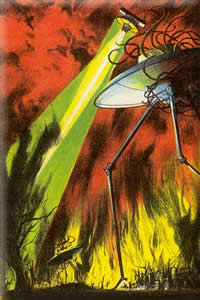 "You can easily understand why, though," Corso said, "if you remember, as I do, the Mercury Theater 'War of the Worlds' radio broadcast in 1938 when the entire country panicked at the story of how invaders from Mars landed at Grovers Mill, New Jersey, and began attacking the local populace. The fictionalized eyewitness reports of violence and the inability of our military forces to stop the creatures were graphic. They killed everyone who crossed their path, narrator Orson Welles said into his microphone, as these creatures in their war machines started their march toward New York. The level of terror that Halloween night of the broadcast was so intense and the military so incapable of protecting the local residents that the police were overwhelmed by phone calls. It was as if the whole country had gone crazy and authority itself had started to unravel." Thus when Corso was given in 1961 what he often called "the nut file," the cabinet containing some of the debris from the Roswell crash, it had long ago been decided that the aliens were hostile and that the country had an urgent need to develop weapons that could truly do some damage to the UFOs should war ever break out between mankind and the aliens. And the whole business had to be conducted in secrecy in order to prevent a public panic that would critically disable any efforts to resist the feared invasion. "You can easily understand why, though," Corso said, "if you remember, as I do, the Mercury Theater 'War of the Worlds' radio broadcast in 1938 when the entire country panicked at the story of how invaders from Mars landed at Grovers Mill, New Jersey, and began attacking the local populace. The fictionalized eyewitness reports of violence and the inability of our military forces to stop the creatures were graphic. They killed everyone who crossed their path, narrator Orson Welles said into his microphone, as these creatures in their war machines started their march toward New York. The level of terror that Halloween night of the broadcast was so intense and the military so incapable of protecting the local residents that the police were overwhelmed by phone calls. It was as if the whole country had gone crazy and authority itself had started to unravel." Thus when Corso was given in 1961 what he often called "the nut file," the cabinet containing some of the debris from the Roswell crash, it had long ago been decided that the aliens were hostile and that the country had an urgent need to develop weapons that could truly do some damage to the UFOs should war ever break out between mankind and the aliens. And the whole business had to be conducted in secrecy in order to prevent a public panic that would critically disable any efforts to resist the feared invasion.
The obvious starting place, Corso said, would be to analyze and then duplicate some of the artifacts that had been collected after the Roswell crash. The term used was "reverse-engineering," which meant to figure out how the alien technology worked and then turn it to the military's advantage. If we could give the aliens back what they intended to give us, then maybe we stood a chance of holding our own in a shooting war with the UFOs.
Together with his commanding officer, Lieutenant General Arthur G. Trudeau, Corso said he developed a plan to "seed" the technologically advanced artifacts to defense contractors who were already working on similar projects. But this had to be done, for the most part, without telling the scientists involved where the artifacts had come from. The idea was to drop the alien technology into the loop of research already underway, thus concealing its alien origin. It would look like the finished product had been developed by earthly scientists in the natural course of their work, Corso said. The Army would offer to fund the work completely and would even permit the various contractors to patent the resulting products themselves.
"As General Twining had suggested in his report to the Army Air Force," Corso said, "'foreign technology' was the category to which research on the alien artifacts from Roswell was to be delegated. Foreign technology was one of the great catch-all terms, encompassing everything from researching French air force engineering advances on helicopter blades to captured Russian MiGs flown in from Cuba. Foreign technology was the absolute perfect cover. All I had to do was figure out what to do with the stuff I had."
According to Corso, he eventually did figure out where to take much of the debris for reverse engineering. Companies like Bell Labs, IBM, Dow Corning and Hughes Aircraft subsequently managed to create new technological breakthroughs that gave the U.S. a decided edge in a projected military response to the aliens.
Among the products that Corso says resulted from the Roswell debris were:
1. . Image intensifiers, which ultimately became "night vision"
2. . Fiber optics
3. . Supertenacity fibers
4. . Lasers
5. . Molecular alignment metallic alloys
6. . Integrated circuits and microminiaturization of logic boards
7. . HARP (High Altitude Research Project)
8. . Project Horizon (an attempt to sell the government on the necessity of building a military base on the Moon to compete with both the Russians and the aliens.)
9. . Portable atomic generators (ion propulsion drive)
10. . Irradiated food
11. . "Third Brain" guidance systems (based on the headbands reportedly used by the aliens)
12. . Particle beams ("Star Wars" antimissle energy weapons)
13. . Electromagnetic propulsion systems
14. . Depleted uranium projectiles
Corso had access to most of the preeminent scientists in fields related to the development of the technology listed above. But one is forced to question whether he is telling the absolute truth in regard to two scientists who had never publicly acknoweldged that they knew anything at all about the Roswell crash.
One of those scientists is Dr. Wilbert Smith, who, according to Corso, wrote a memo in 1950 that urged the government of Canada to investigate the nature of alien technology that the United States had retrieved from crashed extraterrestrial vehicles.
Corso said that his commanding officer, General Trudeau, had joked that although Smith knew that we had acquired technology at Roswell, he didn't really know what it was.
"I can't wait to see his face when you open your briefcase in front of him, Phil," the general said, thinking about how his old friend had always wanted to know the specifics of what he had secreted away in 1947.
The problem is, and this is also true of statements Corso makes about Professor Herman Oberth later in the book, there was never any public statement made by either scientist about their having any prior knowledge at all about Roswell. Even though they spoke in contexts where they were withholding nothing, the idea of their having known about the crash or the technology that later came from it does not appear anywhere in the public record.
Corso also recounts conversations with the likes of then Attorney General Robert F. Kennedy and J. Edgar Hoover, both of whom were in dire need of the intelligence he had to offer. He even claims to have been the person who leaked the buildup of Russian nuclear missiles in Cuba to the press in October of 1962, thus creating the Cuban Missile Crisis. President Kennedy had been refusing to take action about the Russian missiles being shipped to Cuba, Corso tell us, because he was being fed false intelligence reports by the CIA, whose real loyalty was to the KGB. By his own account, it was Corso who had stepped in and saved the day.
In any case, after many years of sweat and strain, good old American know-how eventually led to that list of 14 "inventions" mentioned earlier. Ronald Reagan's courage in fighting for the Strategic Defense Initiative against a great deal of political resistance led to the country's having a viable military defense in outer space against an alien invasion. Corso maintains that the implementation of the "Star Wars" project led to the end of the Cold War. And, while neither Reagan or Chairman Mikail Gorbachev said so publicly, the U.S. and Russia now present a united front against the common alien enemy. The paranoia that had existed between the two countries since the end of World War II had now given way to a determination to fight together for the sake of mankind as a whole.
"These creatures weren't benevolent alien beings," Corso said, "who had come to enlighten human beings. They were genetically altered humanoid automatons, cloned biological entities, actually, who were harvesting biological specimens on Earth for their own experimentation. As long as we were incapable of defending ourselves, we had to allow them to intrude as they wished.
"They dictated the terms," he continued, "because they knew that what we most feared was disclosure. Hide the truth and the truth becomes your enemy. Disclose the truth and it becomes your weapon."
|
